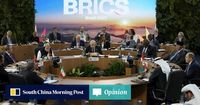As the summer of 2025 unfolds, a new chapter in global economic and diplomatic relations is being written, and the ink is coming from some unexpected pens. The BRICS bloc—Brazil, Russia, India, China, and South Africa—finds itself not on the defensive, but rallying together in the face of escalating trade and currency hostilities from the United States under President Donald Trump. What was perhaps intended as a show of American strength is, in a twist of fate, forging tighter bonds among the world's leading emerging economies.
On August 13, 2025, Brazilian President Luiz Inácio Lula da Silva, known simply as Lula, took a bold public stance against the dominance of the US dollar. Declaring what he called a "war on the US dollar," Lula demanded the creation of a new BRICS currency, signaling a major push for de-dollarisation within the bloc. According to reports cited by India.com and other international outlets, this move is part of a broader campaign by Lula to reform global trade and payment systems, reduce reliance on the dollar, and promote digital currency initiatives among BRICS nations.
Lula's rhetoric has sharpened in recent weeks. He has openly criticized what he calls "US protectionism" and warned that BRICS is prepared to retaliate against new American tariff threats. "We will fight on all fronts," Lula declared, as reported by multiple sources, including a memorable headline: "Brazil's LULA Declares War On Trump As Tariff Tensions EXPLODE." The message is clear—Brazil, and by extension BRICS, is not backing down.
The latest flashpoint in this escalating standoff came when the US announced a staggering 50% tariff on Brazilian goods. The move, which coincided with domestic political tensions in Brazil surrounding the trial of former President Jair Bolsonaro, has only deepened the rift. Lula, never one to mince words, fired back at Trump, warning of consequences for what he sees as economic bullying. "If Trump dares to…"—the unfinished sentence, quoted in Indian and Brazilian media, hangs in the air as both a threat and a promise of resistance.
But Brazil is not alone in feeling the heat from Washington. India, another key BRICS member, has also found itself targeted by Trump's aggressive trade agenda. After a brief period of diplomatic warmth—Prime Minister Narendra Modi was among the first to meet Trump upon his return to the White House—relations soured rapidly. Trump imposed a 50% tariff on Indian exports and, in a move that raised eyebrows in New Delhi, hosted Pakistan’s army chief Asim Munir for a private lunch at the White House in June 2025. For India, which has long viewed Pakistan with suspicion, the gesture was a diplomatic slap in the face.
The Indian Ministry of External Affairs condemned the subsequent US decision to levy an additional 25% tariff on Indian imports of discounted Russian oil, calling the measure "unjustified and unreasonable," according to a report in South China Morning Post. The friction has prompted Indian officials to look eastward—and southward—for new partnerships and support.
In a notable shift, India and China are now moving to improve their own bilateral relations. Diesel exports from India to China have resumed, and China has eased restrictions on urea exports to India, a small but telling sign of thawing relations after years of tension following the 2020 Galwan Valley clash. Direct flights between the two Asian giants are also set to resume, with the Modi government announcing plans to grant tourist visas to Chinese citizens for the first time since the COVID-19 pandemic shut down travel. Prime Minister Modi is scheduled to visit China later this year to attend the Shanghai Cooperation Organisation (SCO) summit, and India is set to assume the BRICS chairmanship soon—developments that could see Chinese President Xi Jinping making a reciprocal visit to India.
According to India.com, these moves are not just about bilateral ties; they are about fortifying the BRICS bloc as a whole. With the US ramping up economic pressure, the five-member group is banding together to "rein in Donald Trump." The sense of urgency is palpable. As one Indian official put it, "BRICS nations, including India, China, Russia, and Brazil, could strengthen cooperation to counter US policies under Trump."
Russia, too, remains at the center of these shifting alliances. On August 11, 2025, Russian President Vladimir Putin briefed Lula on the latest Ukraine peace talks and discussed the impact of Trump’s tariffs. While Trump has tried to position himself as a peacemaker in the Ukraine conflict—evoking the ghost of Nixon’s diplomatic maneuvers—his actions have only heightened tensions. After former Russian president Dmitry Medvedev made public comments about Russia’s nuclear strike capabilities, Trump responded on social media by announcing that he had ordered US nuclear submarines to be positioned in "the appropriate regions." The Russian Foreign Ministry then declared that Moscow was no longer bound by a moratorium on the deployment of short- and medium-range nuclear missiles, raising the specter of a new arms race.
Yet, as the South China Morning Post points out, Trump’s hardline approach isn’t breaking BRICS apart—it’s driving its members closer together. India, often seen as a "swing state" between East and West, is now leaning into its role as a leader within BRICS. The bloc’s unity is being tested, but so far, it’s holding strong. The prospect of a new BRICS currency and digital payment systems, championed by Lula and echoed by other leaders, is no longer just a talking point—it’s a rallying cry.
China, meanwhile, has softened its stance toward India and is signaling its intent to work more closely with fellow BRICS members. The resumption of trade and travel is only the beginning. With India poised to take the BRICS chairmanship, the group is preparing to set its own agenda—one that may include a coordinated response to US tariffs, new trade agreements, and, if Lula has his way, the formal launch of a BRICS currency to challenge the global dominance of the dollar.
For the US, the consequences of this strategy are becoming clear. Rather than isolating or weakening the BRICS bloc, Trump’s tariffs and threats have created a common adversary for Brazil, Russia, India, and China. The result? A more united BRICS, determined to chart its own course in the face of American pressure.
As the world watches, the next moves will be critical. Will the US double down, or will it seek new ways to engage with a bloc that’s growing more confident by the day? For now, one thing is certain: the global order is shifting, and the BRICS nations are no longer content to play by someone else’s rules.





